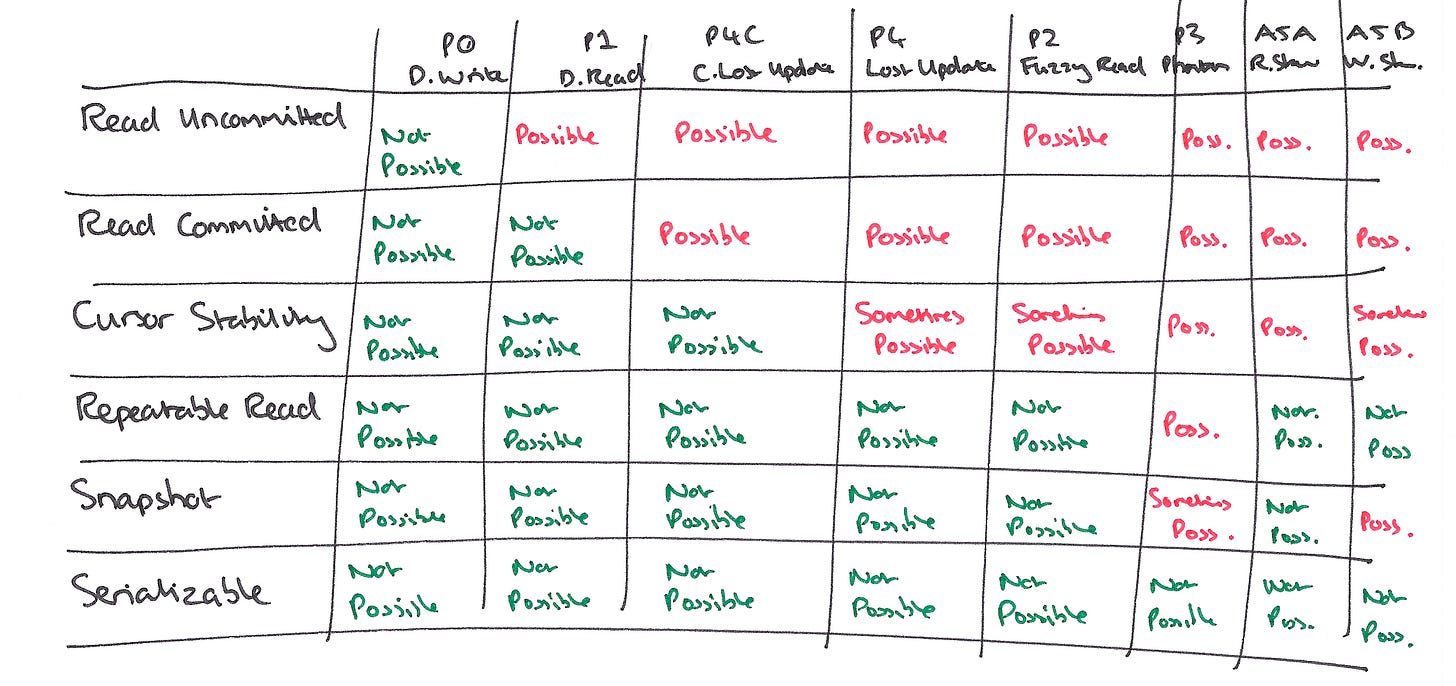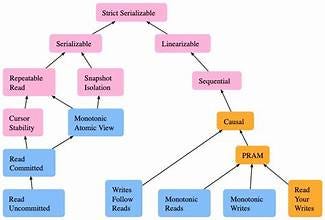Different isolation levels in databases
In database management, isolation levels define the extent to which transactions are isolated from one another in terms of visibility and interactions with data that is being modified.
1. Read Uncommitted
Description:
The lowest level of isolation.
Transactions can read data that has been modified but not yet committed by other transactions (dirty reads).
Provides the highest concurrency but the lowest data consistency.
Possible Issues:
Dirty Reads: A transaction can see uncommitted changes made by other transactions.
Non-Repeatable Reads: The same query may return different results if another transaction modifies the data.
Phantom Reads: New rows added by another transaction may appear in subsequent reads.
Use Case:
Situations where performance is more critical than consistency.
Example: Logging or analytics where temporary inconsistencies are acceptable.
2. Read Committed (Default in Most Databases)
Description:
A transaction can only read data that has been committed by other transactions.
Prevents dirty reads but still allows non-repeatable reads and phantom reads.
Possible Issues:
Non-Repeatable Reads: A transaction may see changes made by other committed transactions between two reads of the same data.
Phantom Reads: New rows added by another transaction may appear in subsequent queries.
Use Case:
Most common use case in OLTP systems where some consistency is needed but performance is also important.
Example: Banking systems where balances are frequently queried but intermediate states aren't exposed.
3. Repeatable Read
Description:
Ensures that if a transaction reads the same data twice, it will get the same result both times, even if other transactions modify the data in the meantime.
Prevents dirty reads and non-repeatable reads but does not prevent phantom reads.
Possible Issues:
Phantom Reads: New rows added by another transaction may still appear in subsequent queries.
Use Case:
Useful in scenarios where ensuring that multiple reads return consistent results is critical.
Example: Financial applications requiring stable views of data during a transaction.
4. Serializable (Highest Isolation Level)
Description:
Ensures full isolation by serializing transactions, meaning they are executed as if they happened sequentially.
Prevents dirty reads, non-repeatable reads, and phantom reads.
Provides the highest level of consistency but at the cost of performance and concurrency.
Possible Issues:
Locking and Blocking: Transactions may experience delays due to locks.
Deadlocks: High contention for resources may result in deadlocks.
Use Case:
Scenarios requiring absolute consistency, such as critical financial transactions or systems where data integrity is paramount.
Example: Ledger updates in accounting systems.
Examples of Issues
Dirty Read (Read Uncommitted)
Transaction 1 modifies a row but hasn't committed yet. Transaction 2 reads this uncommitted data and acts on it. If Transaction 1 rolls back, Transaction 2 has acted on invalid data.
Non-Repeatable Read (Read Committed)
Transaction 1 reads a row. Before it reads it again, Transaction 2 modifies and commits the data. The second read returns a different value.
Phantom Read (Repeatable Read)
Transaction 1 queries a range of rows. Before querying again, Transaction 2 inserts new rows that match the query's criteria. The second query returns additional rows.
Choosing the Right Isolation Level
Read Uncommitted:
Use when performance is critical, and consistency is less important.
Example: Logging systems.
Read Committed:
Default for most databases; balances performance and consistency.
Example: Most OLTP systems.
Repeatable Read:
Use when consistent data reads are needed, but slight performance loss is acceptable.
Example: Applications that read data multiple times during a transaction.
Serializable:
Use only when absolute consistency is required, and performance trade-offs are acceptable.
Example: Financial systems where strict consistency is crucial.
Conclusion
The choice of isolation level depends on the trade-off between consistency and performance based on the application's requirements. Start with the default Read Committed and adjust as necessary based on specific use cases or consistency needs.
source image:-wikipedia



